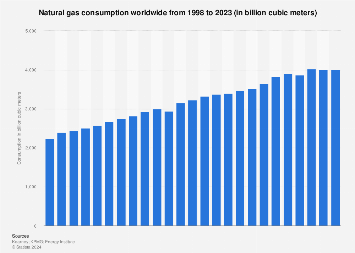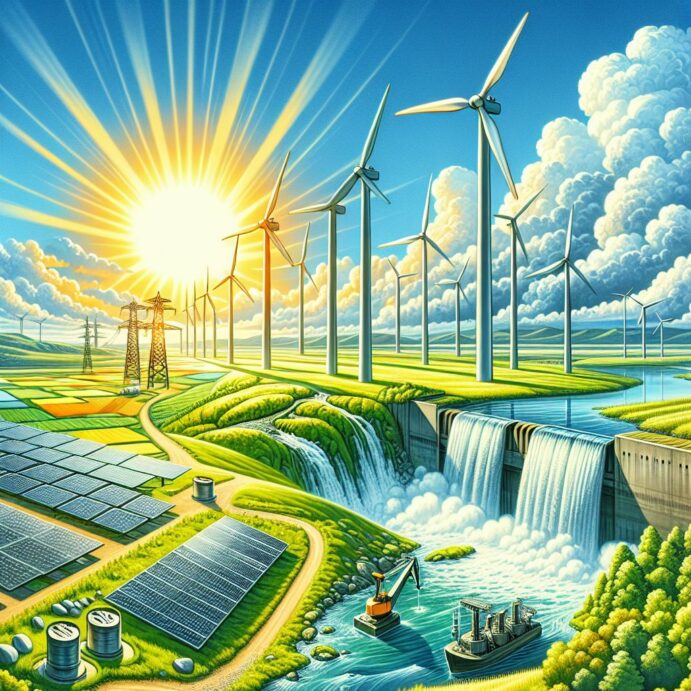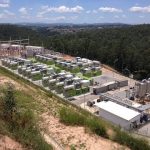Key Points to make Straight Away About “Is Natural Gas Renewable or Nonrenewable”
- Natural gas is primarily nonrenewable, formed from ancient organic matter over millions of years.
- It is a significant source of energy globally, powering industries, homes, and transportation.
- Natural gas extraction can harm the environment, affecting air quality and contributing to climate change.
- While nonrenewable, some aspects like landfill gas provide renewable methane sources.
- Transitioning to renewable energy requires understanding the limitations and benefits of natural gas.
Understanding the Nature of Natural Gas
When we talk about natural gas, we're discussing a crucial player in the global energy landscape. This energy source fuels homes, industries, and even some vehicles. But what exactly is natural gas, and why is it often labeled as nonrenewable? Let's dive into the details.
Natural gas is a fossil fuel, primarily composed of methane, a simple hydrocarbon. This gas is found deep beneath the earth's surface and is extracted for various uses. It's a cleaner-burning alternative to other fossil fuels like coal and oil, but it still has its environmental drawbacks.
Understanding natural gas involves exploring its origins, extraction methods, and its role in our energy systems. Most importantly, it requires us to examine its renewability—or lack thereof—so we can make informed decisions about our energy future.

“Natural Gas Vs Non Renewable Energy …” from 8billiontrees.com and used with no modifications. Is Natural Gas Renewable or Nonrenewable? – Did you ever imagine dinosaurs were renewable?
What is Natural Gas?
Natural gas is a colorless, odorless fuel that has become a staple in energy production worldwide. It consists mainly of methane but also includes small amounts of other gases such as ethane, propane, and butane. These gases are collectively known as hydrocarbons.
Because of its high energy content and cleaner burning properties, natural gas is often used in power generation, heating, and as a feedstock in chemical manufacturing. It's an integral part of our daily lives, providing energy for cooking, heating, and electricity.
Formation Process
The formation of natural gas is a fascinating natural process that spans millions of years. It originates from the remains of ancient marine organisms that settled on the ocean floor. Over time, these organic materials were buried under layers of sediment, where heat and pressure transformed them into hydrocarbons.
As these hydrocarbons became trapped under impermeable rock layers, they formed reservoirs of natural gas. This process is why natural gas is considered nonrenewable—it's a resource that took millions of years to form and cannot be replenished on a human timescale.
Natural Gas Extraction Methods
Extracting natural gas involves several methods, each with its own environmental impact. The most common technique is drilling, where wells are drilled into the earth to access gas reservoirs. Once drilled, the gas flows to the surface through pipelines.
Another method is hydraulic fracturing, or fracking, which involves injecting high-pressure fluid into rock formations to release trapped gas. While effective, fracking has raised environmental concerns due to its potential to contaminate groundwater and induce seismic activity.
Besides that, there's also the extraction of shale gas, which requires horizontal drilling and fracking to access gas trapped in shale rock formations. These methods have significantly increased natural gas production but have also sparked debates about their environmental sustainability.
Exploring the Renewable vs. Nonrenewable Debate
Now that we understand what natural gas is and how it's extracted, it's crucial to explore the debate surrounding its renewability. This discussion “Is Natural Gas Renewable or Nonrenewable?” is vital for those of us seeking sustainable energy solutions.
Characteristics of Renewable Energy Sources
Renewable energy sources are those that can naturally replenish over short periods. They include solar, wind, hydroelectric, and biomass energy. These sources are sustainable because they rely on natural processes that are constantly renewed.
In contrast, fossil fuels like natural gas are finite. They originate from ancient organic matter and require millions of years to form. Therefore, they are not considered renewable because once depleted, they cannot be readily replaced.

“Natural Gas – Knowledge Bank – Solar …” from solarschools.net and used with no modifications.
Environmental Impacts of Natural Gas
- Natural gas burns cleaner than coal and oil, producing fewer pollutants.
- Extraction and use of natural gas contribute to greenhouse gas emissions.
- Hydraulic fracturing can lead to water contamination and seismic activity.
Natural gas, while cleaner than other fossil fuels, still poses significant environmental challenges. When burned, it releases carbon dioxide, a greenhouse gas that contributes to climate change. However, it emits less CO2 than coal or oil, making it a preferable option for reducing emissions in the short term.
The extraction process also impacts the environment. Drilling and fracking can disrupt local ecosystems, contaminate water supplies, and lead to habitat loss. These activities release methane, a potent greenhouse gas, which can escape into the atmosphere during extraction and transportation.
Therefore, while natural gas is seen as a bridge fuel to cleaner energy, it is not without its environmental drawbacks. Addressing these challenges is crucial for mitigating its impact on our planet, such as through landfill methane capture technologies.
Effects on Air Quality and Climate Change
Burning natural gas for energy results in the emission of nitrogen oxides, carbon dioxide, and other pollutants that affect air quality. Although these emissions are lower than those from coal and oil, they still contribute to smog and acid rain, impacting human health and the environment.
Most importantly, methane leaks during extraction and transportation significantly contribute to climate change. Methane is over 25 times more effective than carbon dioxide at trapping heat in the atmosphere, making it a critical factor in global warming discussions.
Advantages Over Other Fossil Fuels
Despite its drawbacks, natural gas has several advantages over other fossil fuels. It produces less sulfur dioxide, particulates, and mercury, which are harmful pollutants that affect air quality and public health. Additionally, natural gas plants are more efficient and can be ramped up or down quickly to meet energy demands, providing stability to the energy grid.
Because of these benefits, natural gas is often used as a transitional fuel, helping to reduce reliance on more polluting energy sources while renewable energy infrastructure is developed.
Challenges in Transitioning to Cleaner Alternatives
Transitioning from natural gas to renewable energy sources presents several challenges. One significant hurdle is the existing infrastructure, which is heavily invested in natural gas extraction, transportation, and distribution. Shifting to renewables requires substantial investment in new technologies and systems.
Additionally, natural gas provides a stable and reliable energy supply, something that renewable sources like solar and wind struggle with due to their intermittent nature. Overcoming these challenges requires technological advancements in energy storage and grid management to ensure a consistent energy supply.

Role of Natural Gas in the Energy Landscape
Natural gas plays a pivotal role in the current energy landscape, providing a substantial portion of the world's energy needs. Its abundance and relatively low cost make it an attractive option for many countries looking to balance energy security with environmental concerns.
Globally, natural gas is used in electricity generation, heating, and as a feedstock for chemical production. It supports economic growth by powering industries and creating jobs in extraction and distribution sectors. For a sustainable approach, consider the benefits of landfill gas to energy as an alternative energy source.
However, its role is evolving as the world shifts towards more sustainable energy sources. Understanding this transition is crucial for energy-conscious individuals seeking to reduce their environmental impact. Learn more about the outcomes of COP26 pledges that are influencing this shift.
Current Usage Globally and Locally
Natural gas accounts for approximately 24% of global energy consumption, with major producers including the United States, Russia, and Qatar. In the U.S., natural gas is the largest source of electricity generation, surpassing coal and nuclear power. For more insights into the environmental impact of natural gas, consider exploring the outcomes of COP26 pledges.
Locally, natural gas is used for residential heating, cooking, and as a fuel for vehicles. Its versatility and availability make it a popular choice for both urban and rural areas.

“Global natural gas consumption 2023 …” from www.statista.com and used with no modifications.
Natural Gas vs. Renewable Energy Resources
Comparing natural gas to renewable energy resources highlights the challenges and opportunities in transitioning to a sustainable energy future. While natural gas provides reliable and efficient energy, renewables offer a cleaner and more sustainable option.
Renewables like solar, wind, and hydroelectric power are becoming more cost-competitive with natural gas, driven by technological advancements and policy incentives. However, integrating these sources into the energy grid requires overcoming technical and economic barriers.
Future Prospects and Technological Innovations
The future of natural gas is intertwined with technological innovations that aim to reduce its environmental impact. Carbon capture and storage (CCS) technologies offer potential solutions for capturing emissions from natural gas plants and storing them underground.
Moreover, advancements in renewable natural gas (RNG) production, derived from organic waste, provide a sustainable alternative that can be integrated into existing natural gas infrastructure.

“World Energy Annual Report …” from seekingalpha.com and used with no modifications.
Wrap-Up and Final Insights
Natural gas, while a crucial energy source today, faces challenges in the transition to a cleaner energy future. Its role as a bridge fuel highlights the need for balanced energy strategies that incorporate both fossil fuels and renewables.
For energy-conscious individuals, understanding the complexities of natural gas and its environmental impact is essential for making informed decisions. By supporting policies and technologies that promote cleaner energy, we can work towards a sustainable and resilient energy future.
Summary of Key Information
Natural gas, primarily composed of methane, is a major energy source globally, used for electricity generation, heating, and as a chemical feedstock. While it's cleaner than coal and oil, natural gas is nonrenewable because it forms over millions of years from ancient organic matter. Answering the question of is natural gas renewable or nonrenewable is an important factor. Its extraction and use pose environmental challenges, including greenhouse gas emissions and potential water contamination. However, natural gas serves as a transitional energy source as we shift towards renewables. Technological advancements like carbon capture and renewable natural gas production offer pathways to mitigate its environmental impact.
Potential Directions for Energy Consumers
For those seeking to minimize their carbon footprint, consider supporting policies that promote renewable energy and invest in energy-efficient technologies. Transitioning to renewable energy sources like solar or wind can reduce reliance on natural gas. Additionally, staying informed about advancements in renewable natural gas and carbon capture technologies can guide sustainable energy choices. Engaging in community energy programs and advocating for cleaner energy solutions can also contribute to a more sustainable future.
Frequently Asked Questions on the Topic of Is Natural Gas Renewable or Nonrenewable?
Natural gas plays a significant role in our energy systems, but understanding its complexities is crucial for informed decision-making. Here are some common questions and their answers.
Is there a way to make natural gas renewable?
While traditional natural gas is nonrenewable, renewable natural gas (RNG) offers a sustainable alternative. RNG is produced from organic waste, such as agricultural residues and landfill gas, making it a renewable source of methane. Integrating RNG into existing natural gas infrastructure can reduce reliance on fossil fuels and lower greenhouse gas emissions.
How does natural gas impact global warming?
Natural gas combustion emits carbon dioxide, contributing to global warming. However, methane leaks during extraction and transportation are a more significant concern. Methane is a potent greenhouse gas, with a higher heat-trapping capability than carbon dioxide. Reducing methane emissions through improved infrastructure and monitoring can mitigate its impact on climate change.
- Methane has over 25 times the heat-trapping ability of carbon dioxide.
- Reducing leaks can significantly lower the climate impact of natural gas.
- Carbon capture and storage technologies offer potential solutions for emission reduction.
Can natural gas be replaced by other energy sources?
Yes, natural gas can be replaced by renewable energy sources like solar, wind, and hydroelectric power. These sources are sustainable and have lower environmental impacts. However, transitioning requires substantial investment in infrastructure and technology to ensure a reliable energy supply. Energy storage solutions and grid management innovations are crucial for integrating renewables into the energy system effectively.
How does natural gas compare in cost to renewable energies?
Natural gas is often cheaper upfront due to established infrastructure and abundant supply. However, the cost of renewable energy has been decreasing significantly, making it more competitive. Solar and wind energy costs have dropped dramatically in recent years, and with advancements in technology, renewables are becoming more affordable and accessible. Over time, investing in renewable energy can lead to cost savings and environmental benefits.
What are the main uses of natural gas in households?
Natural gas is widely used in households for heating, cooking, and hot water production. It's a popular choice due to its efficiency and relatively lower emissions compared to other fossil fuels. Many homes use natural gas for space heating and powering appliances like stoves and water heaters. Its availability and reliability make it a convenient energy source for residential use.
Understanding the role of natural gas in our energy landscape is essential for making informed decisions. By exploring alternatives and supporting sustainable practices, we can contribute to a cleaner and more resilient energy future.
Landfill Gas Biogas Plant in Brazil at 29.5MW is Among World's Largest
This Landfill Gas Biogas Plant in Brazil site receives the extracted landfill gas, also known as biogas, from around 8,000 tons of urban waste a day. The landfill thermal power plant has an installed capacity of MW, nearly 30 MW, which can supply power to a city of 300,000 inhabitants. So for this reason, we say […]
Suffolk Landfill Accident US – Workers Died While Trapped in Concrete Pipe
The biggest trending news item on social media over the last month, has been the death of two landfill workers inside a concrete pipe. The accident took place at the Suffolk Landfill in the US. The entire waste industry will be saddened for the loss to the relatives of the men. It is not possible […]






